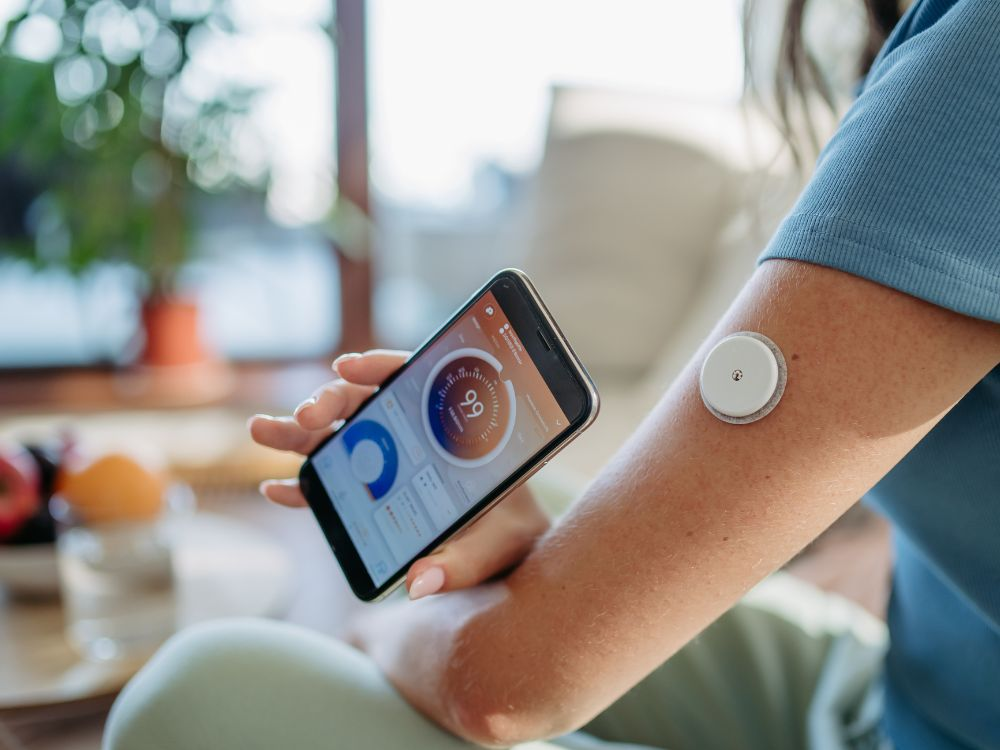Technology has changed how we track blood sugar. A wearable glucose monitor gives you real-time data on the go. Traditional CGM systems offer proven accuracy and long-term tracking. Knowing their strengths and drawbacks will help you decide. This article compares both options to guide your choice.

What Are Wearable Glucose Monitors?
Wearable glucose monitors use small sensors placed under your skin to sample interstitial fluid continuously. You wear them on your arm or abdomen. They send readings every few minutes to a linked device. This constant flow reveals your glucose trends in real time.
Many wearable sensors connect by Bluetooth to your smartphone. You view current levels, trend arrows, and alarms in one app. Most models last seven to fourteen days before you replace them. You insert each sensor with a simple applicator. Their ease of use makes them a popular choice.
Apps display charts and daily reports for deeper analysis. Some devices sync with fitness trackers and smartwatches. Many brands offer factory calibration for hassle-free monitoring. Adhesive patches and waterproof designs suit active lifestyles. This convenience makes monitoring easier than fingerstick tests.
What Are Traditional CGM Systems?
Traditional CGM systems use a separate receiver alongside a sensor under your skin. They require periodic fingerstick calibrations to ensure accurate readings.
Sensor and Transmitter Setup
Traditional sensors connect to a transmitter worn on the body. A small filament samples interstitial fluid and sends data every five minutes. Many transmitters clip onto the sensor and remain in place for ten to fourteen days. You insert them with an applicator tool. The combination of sensor and transmitter forms the core monitoring hardware. They need careful placement for reliable data collection.
Receiver and Display
A dedicated receiver shows glucose readings on a larger screen. It stores data between uploads and provides alarms for low or high levels. The receiver can display trend graphs and statistics at a glance. You might carry it in a pocket or attach it to a belt clip. That visibility suits users with vision changes.
Calibration and Data Upload
Traditional CGMs need fingerstick calibrations two to four times daily. You use a glucose meter to confirm sensor accuracy. Calibrations keep readings within one percent of true blood sugar values. Data uploads occur via USB or wireless connection to a computer or smartphone app. Reliable uploads keep you informed across devices.

Pros of Wearable Glucose Monitors
Wearable glucose monitors offer instant access to real-time data on your smartphone. You don’t need a separate receiver or bulky device.
Seamless Smartphone Integration
Wearable monitors sync with your phone via Bluetooth. You view current glucose levels, trends, and alerts in one app. Notifications pop up even when your phone is locked. That integration simplifies data access. You avoid carrying an extra device. Some apps also sync with smartwatches and fitness trackers. You can customize vibration or sound alerts for each reading.
Minimal Calibration Requirements
Many wearable sensors come factory-calibrated. They eliminate the need for routine fingerstick checks. This reduces your daily tasks and potential errors. You can trust readings as soon as you apply the sensor. Some models still allow manual calibration for fine-tuning. Calibration options vary by brand. These steps simplify your day-to-day routine.
Discreet Design and Comfort
Wearable sensors have low profiles under clothing. Most are about the size of a coin. You can swim, shower, and exercise without worry. Flexible adhesives hold devices in place during movement. Their slim design blends in on the skin. Sensors fit under most clothing without drawing attention.
Cons of Wearable Glucose Monitors
Wearable monitors rely on smartphone apps and wireless connections. You might face battery drain and occasional data delays.
Battery and Connectivity Issues
Bluetooth keeps devices linked to your phone. A low phone battery can interrupt data flow. That leaves you without real-time updates. You might miss a low or high alert. Keep a power bank handy for extended outings. Charging schedules must sync with sensor wear. Backup power options can help.
Adhesive and Skin Reactions
Sensor adhesives can loosen on oily or wet skin. Sweat, lotion, or hair can affect adhesion. You may need extra tape or barrier wipes. Some users develop mild irritation or redness. Rotating sensor locations helps prevent soreness. Consult your provider about protective barrier products.
Ongoing Supply Costs
You pay for sensors and any optional accessories. Even factory-calibrated sensors need replacement. Additional patches or tapes add expense. Insurance coverage varies by brand and region. You may need new prescriptions for each order. Budget planning helps you avoid unexpected expenses.

Pros of Traditional CGM Systems
Traditional CGM systems deliver proven clinical accuracy and full data handling. Many models link directly with insulin pumps for automated support.
High Clinical Accuracy
Traditional sensors often show strong accuracy across glucose ranges. They use fingerstick calibration to maintain precision. Clinical trials back their performance claims. You can trust readings during rapid glucose changes. Users report reliable results even during rapid glucose swings. Many healthcare professionals recommend these models.
Pump Integration
Many traditional CGMs connect directly to insulin pumps. That integration enables automated insulin adjustments. You reduce manual dosing errors. You can set target glucose levels for pump commands. The closed-loop system offers tighter control. Automated systems can adjust insulin doses without manual input.
Comprehensive Reporting Tools
Dedicated receivers provide detailed trend graphs and statistics. You can generate 14-day reports for clinic visits. Data exports support discussion with healthcare teams. Some systems offer online portals and dashboards. Reports help identify patterns in meals and activity. Reports support detailed therapy adjustments between clinic visits.
Cons of Traditional CGM Systems
Traditional CGM systems need regular fingerstick calibrations and separate hardware. Carrying a receiver and meter feels cumbersome.
Frequent Calibration Demands
You must perform two to four fingersticks daily. Each calibration ensures sensor accuracy. Missing a calibration can skew readings. That exposes you to risk during glucose swings. Strict schedules may not suit everyone’s daily routine. Consistency is crucial for safe monitoring.
Bulky Hardware
Traditional systems use separate receivers and meters. You might carry both devices daily. That can feel heavy or awkward. You may need pockets or a bag organizer. Extra hardware complicates travel. Extra weight can affect comfort during exercise or sleep.
Limited Mobile Integration
Many traditional CGMs lack full smartphone connectivity. You cannot view data on your phone directly. You depend on syncing via cables or non-trendy apps. Real-time remote monitoring by family may be limited. Older models may lack modern interface features. This reduces flexibility in data access.
Key Differences and Considerations
Each system has its own strengths in convenience, accuracy, and connectivity. Your choice depends on lifestyle, clinical needs, and budget.
- Wear time: wearables up to 14 days; traditional sensors last 10–14 days.
- Calibration: Wearables are often factory-calibrated; traditional systems need daily fingersticks.
- Hardware: wearables use your phone; traditional CGMs require extra receivers.
- Data features: wearables offer modern apps; traditional CGMs provide detailed clinical reports.
- Integration: wearables link with fitness trackers; traditional systems tie into insulin pumps.
- Cost and coverage: Compare out-of-pocket expenses and insurance benefits before choosing.
Finding Your Perfect Glucose Monitor
Choosing between a wearable glucose monitor and a traditional CGM is about matching the device to your lifestyle. Wearable monitors offer seamless convenience and modern app features. Traditional systems deliver clinical accuracy and deep integration with pumps. Think about calibration needs, device comfort, and how you share data. Your ideal system will fit your routine and health goals.
Visit UroStat Healthcare to explore our range of wearable and traditional CGM devices. We handle all your insurance paperwork so you’re covered from start to finish. With valid insurance, your supplies ship free to your door. Contact us today!



